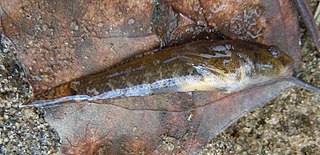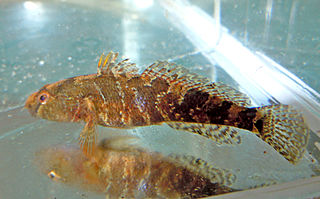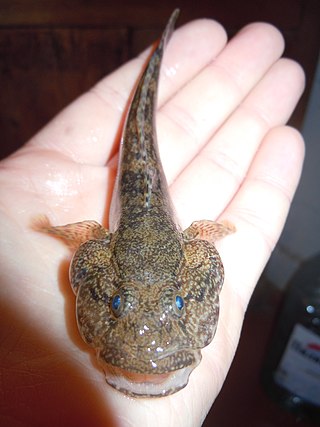
The racer goby is a species of goby native to fresh, sometimes brackish, waters, of the Black Sea basin. It is a Ponto-Caspian relict species. The species is placed a monotypic genus, Babka, which was once considered a subgenus of genus Neogobius, but was then elevated to genus-status based on the molecular analysis.

Ponticola kessleri, the bighead goby or Kessler's goby, is a species of goby native to Eurasia. The bighead goby is a Ponto-Caspian relict species. It inhabits the fresh and oligohaline waters, with mineralisation from 0-0.5‰ up to 1.5-3.0‰.

The Syrman goby is a species of goby native to marine, brackish and probably fresh waters of the Black Sea, the Sea of Azov and the Caspian Sea basins. They inhabit inshore waters with substrates composed of shell fragments, sand, mud or muddy sand. This species can reach a length of 24.5 centimetres (9.6 in) TL.

Ponticola is a genus of gobies native mostly to fresh waters of the Black Sea - Caspian Sea region in Eurasia. Some species occur in the brackish-water Black and Caspian seas themselves. It was considered to be part of the broader goby subfamily Benthophilinae, also endemic to the same region, although the 5th edition of Fishes of the World does not list any subfamilies in the Gobiidae. Originally, Ponticola was described as subgenus of Neogobius.

The mushroom goby is a species of goby native to the Black Sea where it can be found along the coasts from Bulgaria to the Crimea. Mostly a species of marine and brackish waters, it is known to enter fresh waters in the delta of the Danube River. This species prefers inshore waters with rocks or fallen trees. This species can reach a length of 20 centimetres (7.9 in) TL.

Proterorhinus semipellucidus is a species of gobiid fish, a tubenose goby originally described from the Gharasu River near Gorgan Bay of the Caspian Sea in Iran. Following the systematic decomposition of the tubenose gobies it was suggested to be a more widespread and invasive taxon distributed in the fresh waters of the Caspian Sea basin. It may be the same species as that known as Proterorhinus nasalis.

The tadpole-gobies (Benthophilus), also called pugolovkas, are a genus of Ponto-Caspian fishes in the family Gobiidae.

Proterorhinus is a genus of fishes, known as the tubenose gobies. These gobiid fish are native to Eurasia where they occur in the region of the Caspian and Black seas, inhabiting marine, brackish and fresh waters. The species Proterorhinus semilunaris was introduced to the St. Clair River in Michigan during the late 1990s. Until recently, the genus was considered monotypic, comprising only the tubenose goby. Following molecular and further morphological investigations it has been split into several taxa, with distinct distributions in marine vs. fresh waters and in the Black Sea vs. Caspian Sea basins.

Pinchuk's goby is a species of goby native to the Black Sea and the Sea of Azov.

The flatsnout goby is a species of goby endemic to the Black Sea where it is mostly known from inshore waters amongst rocks and boulders. It is occasionally found offshore over areas with gravel substrates. This species can reach a length of 22.5 centimetres (8.9 in) TL.
The Caucasian goby is a species of goby native to rivers of the Caucasus draining to the Black Sea in Europe and Asia. This species is strictly a fresh water species and will not enter brackish water. It can reach a length of 20 centimetres (7.9 in) SL.

Ponticola cyrius, the Kura goby, is a species of gobiid fish endemic to the Kura River in the southern Caucasus countries of Georgia, Turkey, Iran and Azerbaijan. It reaches a length of 13 centimetres (5.1 in) SL. It lives in the upper parts of the Kura River, Massuleh River and the Pasikhan River and in the Anzali Mordab (Iran). Downstream in Kura it is replaced by Ponticola gorlap.

Ponticola gorlap, or the Caspian bighead goby, is a species of goby, a benthic fish native to the Caspian Sea basin. It is widespread in lower parts of many rivers in Iran, and also found in Azerbaijan and Turkmenistan. In Russia, it occurred in the lowest part of the Volga up to Astrakhan until 1977, but has thereafter spread upstream. In 2000 it was recorded as being established in the Ivankovo and Rybinsk Reservoirs in the Moscow region, and already invaded the Don drainage by way of the Volga–Don Canal in 1972. This species occurs in sheltered environments, such as inshore fresh or brackish waters of estuaries, lagoons, lakes and large rivers, where it prefers habitats with a well vegetated rock or firmly packed sand substrate. It can reach a length of 20 centimetres (7.9 in) SL, and a common size is 12 centimetres (4.7 in) SL.
Turan's goby is a Ponto-Caspian species of goby endemic fish native to Turkey where it is only found in the Aksu Deresi stream. This species is found in a fresh water stream with a substrate of rounded pebbles. Males of this species can reach a length of 8.8 centimetres (3.5 in) SL while females only reach 8.3 centimetres (3.3 in) SL.
The riverine goby is a species of gobiid fish native to rivers in the north-eastern part of the Black Sea basin at the border of Europe and Asia. It is one of the numerous species of benthophiline gobies endemic to the Ponto-Caspian region. It is known to occur in the basins of rivers north of the Bzyb Range and also in the Kuban River basin. This fish can be found in both fresh and brackish waters. It can reach a length of 14 centimetres (5.5 in) TL.

The Benthophilinae are a subfamily of gobies endemic to the Ponto-Caspian region. The subfamily includes about 50 species. The representatives of the subfamily have fused pelvic fins and elongated dorsal and anal fins. They are distinguished from the closely related subfamily Gobiinae by the absence of a swimbladder in adults and location of the uppermost rays of the pectoral fins within the fin membrane.
Neogobius pallasi, the Caspian sand goby or the Caspian monkey goby, is a species of fish native to fresh and brackish waters of the Caspian Sea basin including the Volga drainage up to the vicinity of Moscow. It has been introduced into the Aral basin. This species of goby can reach a length of 20 centimetres (7.9 in) SL. It is also important to local commercial fisheries.

Neogobius bathybius is a species of goby endemic to the Caspian Sea, where it occurs in depths down to 200 metres (660 ft). It is strictly confined to the brackish-water basin and does not enter fresh waters. It can grow up to a length of 25 centimetres (9.8 in) TL.
Hyrcanogobius bergi, the Volga dwarf goby, is a species of goby endemic to the Caspian Sea where it occurs in fresh, brackish and marine waters along the coast. Unusually for gobies, this species is almost a pelagic fish. This species grows to a length of 3.6 centimetres (1.4 in) SL. This species is the only known member of its genus. The specific name honours the Soviet zoologist Lev Berg (1876-1950) who described many new species of goby from the Caspian Sea.













